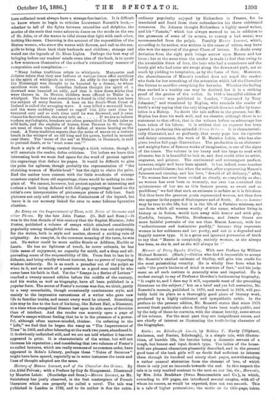ordinary popularity enjoyed by Richardson in France, for he translated
and freed from their redundancies his three celebrated romances. Dr. Johnson thought Richardson a highly moral writer, and his "Pamela," which has always seemed to us, in addition to the grossness of some of its scenes, to convey a bad moral, was recommended from the pulpit. Possibly Manon Lescaut, which, according to its author, was written in the cause of virtue, may have also won the approval of the great Chem of letters. No doubt every deviation from the right path brings sorrow upon Manon and her lover ; bat at the same time the reader is made to feel that owing to the irresistible force of love, the hero who had a conscience and the lovely girl who had none are swept along the downward path, not so much by yielding to temptation, as by the force of fate. Moreover, the shamelessness of Manon's conduct does not repel the reader, who feels for her something of the attraction which led the Chevalier des Grieux to sacrifice everything for her sake. Whether the feeling thus excited is a healthy one may be doubted, but it is a striking proof of the genius of the writer. In 1811 a beautiful edition of Manon Lescaut was published in London, "illustrated by Tony Johanna," and translated by Moylan, who reminds the reader of Swift's witty saying that the only thing which does not suffer by trans- lation is a Bishop. No doubt the tale suffers in the process, but Mr. Moylan has done his work well, and we observe, although there is no statement to that effect, that in the volume before us advantage has been taken of his labour. It is evident that no expense has been spared in producing this splendid edition de lu)e. It is characteristi- cally illustrated, and so profusely, that every page has its vignette and dainty ornament, the work of M. Maurice Leloir, who has also given twelve full-page illustrations. The production in an elaborate and weighty form of famous works of imagination, is one of the signs of the times. The volume is too heavy and too large to read with pleasure, but it is beautiful to look at, and does credit alike to artist, engraver, and printer. The sentimental and extravagant preface, however, might well have been spared. It has, indeed, some touches of great truthfulness ; but when the writer, after representing Manon's falseness and canning, and her love, "devoid of all delicacy," adds, "No woman has ever been evoked so clearly, so completely as she ; no woman has ever been so womanly, nor over has contained the quintessence of her sex as this famous person, so sweet and so perfidious," we feel that such an estimate is as false as it is frivolous. Not thus have the greatest poets represented woman, not thus does she appear in the pages of Shakespeare and of Scott. Manon Lescaut may be true to the life, but it is the life of a Parisian mistress, and one from which all women worthy of the name, whether living in history or in fiction, would turn away with horror and with pity. Cordelia, Imogen, Perdita, Dasdemona, and Jeanie Deans are more faithful portraits of the sex than Manon Lescaut, with her "seductiveness and instinctive perfidy," because they represent woman in her nobleness and her purity, and not in a degraded and happily narrow type. It is a gross and ignorant perversion of troth to say that "Manon is completely, entirely woman, as she always has been, as she is, and as she will always be !"


































 Previous page
Previous page